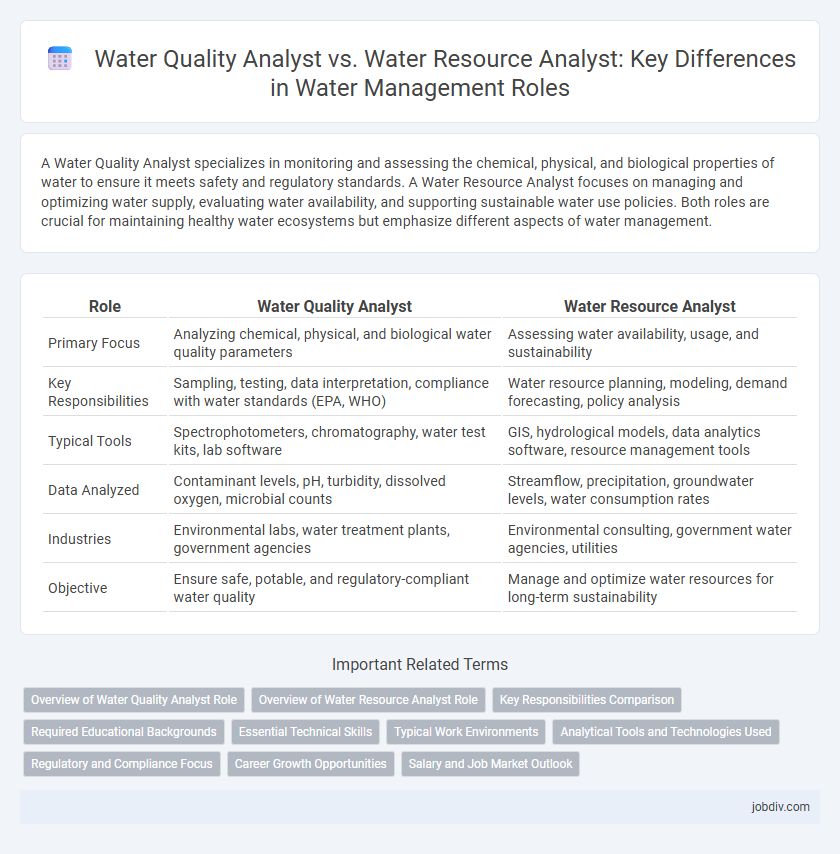A Water Quality Analyst specializes in monitoring and assessing the chemical, physical, and biological properties of water to ensure it meets safety and regulatory standards. A Water Resource Analyst focuses on managing and optimizing water supply, evaluating water availability, and supporting sustainable water use policies. Both roles are crucial for maintaining healthy water ecosystems but emphasize different aspects of water management.
Table of Comparison
| Role | Water Quality Analyst | Water Resource Analyst |
|---|---|---|
| Primary Focus | Analyzing chemical, physical, and biological water quality parameters | Assessing water availability, usage, and sustainability |
| Key Responsibilities | Sampling, testing, data interpretation, compliance with water standards (EPA, WHO) | Water resource planning, modeling, demand forecasting, policy analysis |
| Typical Tools | Spectrophotometers, chromatography, water test kits, lab software | GIS, hydrological models, data analytics software, resource management tools |
| Data Analyzed | Contaminant levels, pH, turbidity, dissolved oxygen, microbial counts | Streamflow, precipitation, groundwater levels, water consumption rates |
| Industries | Environmental labs, water treatment plants, government agencies | Environmental consulting, government water agencies, utilities |
| Objective | Ensure safe, potable, and regulatory-compliant water quality | Manage and optimize water resources for long-term sustainability |
Overview of Water Quality Analyst Role
Water Quality Analysts specialize in testing and monitoring water samples to ensure compliance with environmental standards and public health regulations. They utilize advanced laboratory techniques and instrumentation to detect contaminants, assess chemical and biological parameters, and generate detailed reports for regulatory agencies. Their role is critical in identifying pollution sources, supporting water treatment processes, and safeguarding ecosystems through accurate data analysis.
Overview of Water Resource Analyst Role
Water Resource Analysts evaluate and manage water systems to ensure sustainable use and compliance with environmental regulations, using data analysis and modeling techniques. They assess watershed conditions, water availability, and the impact of human activities on water resources to support policy development and resource planning. This role requires expertise in hydrology, geographic information systems (GIS), and environmental science to guide effective water management strategies.
Key Responsibilities Comparison
Water Quality Analysts focus on assessing chemical, biological, and physical parameters of water samples to ensure compliance with environmental standards and public health regulations. Water Resource Analysts evaluate water availability, usage patterns, and sustainability metrics to inform water management policies and resource allocation. Both roles require data analysis and reporting, but Water Quality Analysts prioritize contamination detection while Water Resource Analysts emphasize long-term water supply planning.
Required Educational Backgrounds
A Water Quality Analyst typically requires a degree in environmental science, chemistry, or biology to specialize in analyzing water samples and ensuring compliance with safety standards. Conversely, a Water Resource Analyst often holds a background in civil or environmental engineering, hydrology, or geography to focus on managing water supply, distribution, and sustainability. Both roles demand strong analytical skills, but their educational backgrounds diverge based on the emphasis on chemistry and biology versus engineering and hydrological sciences.
Essential Technical Skills
Water Quality Analysts require expertise in laboratory testing methods, chemical analysis, microbiological sampling, and data interpretation to assess contaminant levels and ensure compliance with environmental regulations. Water Resource Analysts specialize in hydrological modeling, watershed management, Geographic Information Systems (GIS), and statistical analysis to evaluate water availability, usage patterns, and sustainable resource planning. Both roles demand proficiency in environmental regulations, data management software, and strong analytical skills tailored to their specific focus within water management.
Typical Work Environments
Water Quality Analysts typically work in laboratory settings, environmental consulting firms, and government agencies, focusing on testing and monitoring water contamination levels. Water Resource Analysts operate mainly within governmental departments, research institutions, and environmental planning organizations, analyzing data to manage water supply and distribution. Both roles collaborate with regulatory bodies to ensure compliance with environmental standards and sustainable water management.
Analytical Tools and Technologies Used
Water Quality Analysts predominantly utilize spectrophotometers, atomic absorption spectrometers, and chromatography techniques to assess chemical, physical, and biological parameters in water samples. Water Resource Analysts rely on GIS software, hydrological modeling tools like SWAT and HEC-HMS, and remote sensing technologies to evaluate watershed conditions and water availability. Both roles employ data analytics platforms for interpreting complex datasets, but their toolsets are specialized to monitor quality parameters versus resource distribution and management.
Regulatory and Compliance Focus
Water Quality Analysts specialize in monitoring and evaluating water sources to ensure compliance with environmental regulations such as the Safe Drinking Water Act and Clean Water Act. Their work involves analyzing chemical, biological, and physical parameters to detect pollutants and enforce water quality standards mandated by agencies like the EPA. In contrast, Water Resource Analysts focus on managing water supply systems and policies, emphasizing regulatory compliance with water rights, allocation, and sustainable usage guidelines at local, state, and federal levels.
Career Growth Opportunities
Water Quality Analysts specialize in monitoring and improving water purity, often advancing into roles such as environmental consultants or regulatory affairs managers due to increasing global water safety regulations. Water Resource Analysts focus on sustainable management and allocation of water resources, with career growth into positions like hydrologists or water policy advisors driven by climate change impacts and water scarcity challenges. Both roles offer expanding opportunities in environmental agencies, research institutions, and private sector firms focused on water sustainability and infrastructure development.
Salary and Job Market Outlook
Water Quality Analysts earn an average annual salary ranging from $55,000 to $75,000, reflecting specialized expertise in testing and monitoring water pollutants. Water Resource Analysts typically command higher salaries, between $60,000 and $85,000, due to their broader role in managing water supply and distribution systems. The job market outlook for Water Resource Analysts is projected to grow by 8% over the next decade, driven by increasing water management needs, while Water Quality Analyst positions are expected to grow by 6%, reflecting ongoing environmental regulations and public health concerns.
Water Quality Analyst vs Water Resource Analyst Infographic

 jobdiv.com
jobdiv.com